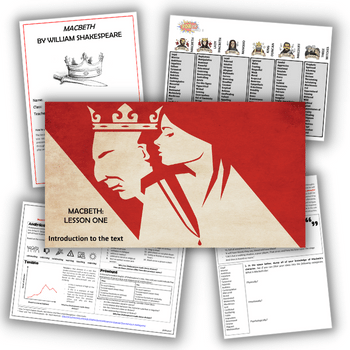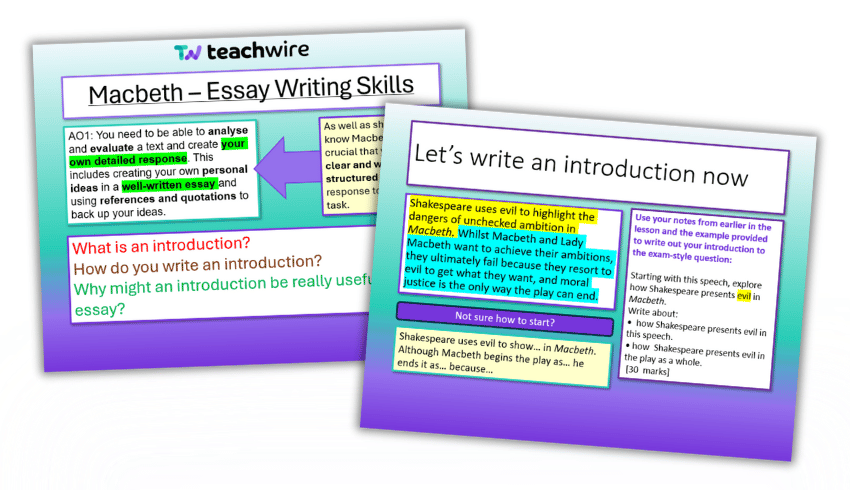Lady Macbeth quotes – Key lines for studying Macbeth in KS4

Lines to remember when discussing the woman behind King Duncan’s murder, and innovative teaching ideas to keep Macbeth fresh…

- by Helen Mears
- English teacher and British Shakespeare Association education committee member

Although she actually appears in around a third of Macbeth, Lady Macbeth’s influence looms large across the text.
Shakespeare shows her as a strong and ruthless woman. She has vaulting ambition and courage. She’s able to push her husband, ‘brave Macbeth’, to do anything for her (including murder Duncan).
Yet she ends the play, and her life, as a broken figure. She’s destroyed by the guilt she has fought so hard to suppress.
Macbeth essay writing resource

This free, detailed Macbeth essay two-lesson resource pack contains two comprehensive PowerPoints which will support KS4 students in constructing coherent and clear essay structures for an exam-style question.
The character frequently appears in exam questions. These are often based on the range of her influence upon Macbeth or the presentation of her as a ‘fiendlike queen”.
As one of Shakespeare’s most powerful and active female characters Macbeth’s ‘dear wife’ provides rich material for essay responses.
Lady Macbeth quotes
“Come you spirits, That tend on mortal thoughts, unsex me here.”
(Act I, Scene V, lines 38-9)
Although oft-quoted, you can use this to kick-start an intriguing discussion over the difference between Lady Macbeth and the Weird Sisters.
Just as they do in their Witches’ Prophecy, Lady Macbeth also calls on evil spirits. Is it only the matter of social class that separates them?
“And when goes hence?”
(Act I, Scene VI, line 58)
This subtle and apparently innocuous response to Macbeth’s statement that Duncan is to stay in their castle is a signal to Macbeth that she is thinking exactly the same thing that he is about the opportunity that this visit brings him.
“Look like th’innocent flower, But be the serpent under’t”
(Act I, Scene VI, lines 64-5)
Another much used quotation, but less well-known is that it refers to a medal James I had struck after the thwarting of the Gunpowder Plot. The head side features a flower and the underside a serpent. This adds more depth to the contextual historical links the play has.
“What beast was’t then, That made you break this enterprise to me?”
(Act I, Scene VII, lines 35-6)
Here Lady Macbeth begins the fierce attack on Macbeth’s masculinity that will batter him into changing his mind over his decision not to kill Duncan.
The key point in this Lady Macbeth quote is that it marks the point at which she no longer uses the intimate ‘thou’ with her husband, but the more distant ‘you’. This is the first sign of a break in their relationship.

Free Shakespeare posters for your classroom
Whether you’re reading Macbeth, Romeo & Juliet, Hamlet, Much Ado About Nothing, Othello or The Tempest, decorate your classroom with these colourful quote posters for students to explore.
“Tis the eye of childhood, That fears a painted devil.”
(Act II, Scene II, lines 64-5).
After calling Macbeth a coward before the murder, she accuses him of acting like a child after it.
“What’s to be done?”
(Act III, Scene II, line 45)
In contrast to her earlier scenes with Macbeth in which she dominated and drove their conversation with long, complex speeches, in this scene, she is reduced to short sentences comprised of monosyllabic words. She is losing control of him and he no longer confides in her.
“Yet who would have the thought the old man to have so much blood in him?”
(Act V, Scene I, lines 35-7)
Trending
A rare hint of compassion from Lady Macbeth, an unconscious moment that shows her guilt and regret at their actions. It’s perhaps a subtle link back to her statement in Act 2 that ‘Had he not resembled, My father as he slept, I had done’t.” (Act II, Scene II, lines 14-5).
She speaks in prose in this scene, slipping from the iambic pentameter of earlier in the play. Elizabethan writers traditionally used prose to express madness. The troubled mind of the speaker breaks down the ordered structure of the iambic rhythm.
Helen Mears is an English teacher, who sits on the education committee of the British Shakespeare Association.
More resources
- Browse great ideas to help with GCSE English Language revision
- Browse Romeo and Juliet KS3 and KS4 resources
- Download our AQA English Literature Paper 1 – Macbeth/Christmas Carol walkthrough
Teaching ideas for ensuring Macbeth stays fresh

The teaching of Macbeth can easily become stale. So allow Meera Chudasama to show how ‘unnatural teaching does breed unnatural lessons’…
Before you start to discuss the context, teach tragedy conventions or even the life of Shakespeare, try taking a line and building a lesson focused on reading for meaning.
Taking a line from Macbeth and exploring it with students will enable them to practise how to inquire independently; to focus on language analysis more naturally, and become familiar with lines before they read them in the play.
It will also allow you to better understand the types of knowledge students already have, and allow them to showcase the links they’re making to their own pools of knowledge.
Test out this approach with these three famous lines from the play:
- ‘Fair is foul and foul is fair’
- ‘What’s done cannot be undone’
- ‘There are scorpions in my mind dear wife’
Encourage reading, reading again and reading once more. Repeating the reading in different voices, at different paces and with emphasis on different words, can spark related thoughts and ideas.
Consider a movement away from what Hywel Roberts in his 2012 book Oops! calls the ‘passive imagination’: “The passive imagination is reinforced by traditional teaching models where questions are asked in order to measure learning, test attentiveness and act as tentpoles to a previous lesson.”
Questioning
Try to ask questions for inquiry and develop students’ imaginative conception of both the characters who speak these lines, and the characters being addressed. Get questioning, either verbally or via a written task – or perhaps through a mixture of both. Here are some questions you could start the students off with:
- What does this line make you feel?
- What do you learn about the person speaking this line?
- Which word in the line feels the most important and why?
- What could have happened to this character?
- How do you think this character would say this line?
- What do you think will happen later in the play, after the character says this line?
If you’re one of those teachers that’s fond of bringing a little drama into the classroom, try printing the lines out and getting the students to deliver them in multiple ways:
- loudly
- quietly
- quickly
- slowly
- emphasising certain words
The students could work in pairs, in groups of three to four, or you could even use them to play musical statues – when the music pauses, students have to deliver the line.
Murder trial
The ‘Macbeth murder trial’ is a great lesson to teach between reading Acts 4 and 5. Before the final death of Macbeth and Lady Macbeth, put Macbeth himself on the stand. Assign roles to each student, and then join in as they place Macbeth under the scrutiny of courtroom.
Hosting a mock murder trial enables you to assess students’ learning while encouraging exploratory talk that will show you how well they’re able to make links between characters and context, and form connections to their prior knowledge.
Step 1: Assign roles
- The Judge: This role is best played by yourself, or by a student who has a good rapport with most in the class
- The Jury: Should ideally consist of up to seven students. The assembled jurors will first need to vote for a foreperson who will read out the final verdict; one must then be designated a ‘patriotic jury member’. They will stand by king and country, regardless of what the evidence says. Of the rest, up to three will be convinced Macbeth is guilty, while the remainder will be unsure
- The Prosecution: Up to three students will be looking to find evidence to convict Macbeth of his crimes. They will need to prove that Macbeth was in his right state of mind when killing King Duncan, and later Banquo.
- The Defence: Up to three students who will defend Macbeth by drawing on the Witches’ prophecy and the influence of Lady Macbeth
- Macbeth: He is pleading guilty, but claims that he wasn’t in a right state of mind, having been influenced by the three witches and his wife.
- Witnesses: These include the Three Witches, Lady Macbeth, the servant working for King Duncan and Banquo
Step Two: Information gathering
Students take a lesson to familiarise themselves with their roles and go through the evidence. The evidence can be drawn from the play itself and any available props, and will be shown in court during the trial.
Step Three: Preparation
The students in the ‘Prosecution’ and ‘Defence’ roles write down what they intend to say upon taking the stand.
Step Four: The verdict
Speeches should be written by the head Juror and the Judge. These will each take around five to ten minutes to deliver.
You can adjust these lessons to be as long or as short as you’d like, depending on the time available to you for reading and analysis.
Write a letter to Lady Macbeth
Here’s a separate activity you can do in addition to, or instead of the full trial activity. Before reading Act 1 Scene 5 of Macbeth, present a creative writing opportunity in which students get the chance to write in character as Macbeth himself, penning a letter to Lady Macbeth. The topic of the letter might include:
- The killing of the traitor
- His feelings about becoming Thane of Cawdor
- His meeting with the three witches
- Banquo’s prophecy
You could set an additional challenge of including a line from the play in the letter. Each letter topic can be planned together in student pairs. Both can use their existing knowledge of the play as well as some contextual knowledge.
At this point in the students’ learning, you can assess what the students have learnt about Macbeth, its collision of the supernatural world with the heroic world, and students’ overall understanding of the play as a whole.
Sentence starters
To take this activity further still, fetch some envelopes and label them with your students’ names. Inside each will be a short message for students to read aloud and peer assess against a criteria suited to your next major assessment point.
These might consist of optional sentence starters, such as:
- I thought it would be important for you to know…
- During my meeting with…
- From speaking to… I heard …
- It is unclear that… therefore, I was hoping you would help me better understand…
- I feel that …
- I truly believe that…
Alternatively, if you’ve read Act 1 Scene 5, get the students to write an unexpected letter from the Witches to Lady Macbeth.
The challenge will be to ensure rhyming couplets are used throughout. Remind students that it’s a rhyme scheme considered to create a spellbinding effect. By simply reading their letters aloud, it could cause the things they describe to happen for real!
- Guess who?
Print pictures representing a range of characters from Macbeth, display them at the front of the classroom and have the students describe out loud who each character is. - What are we asking?
A low-stakes quiz never fails to gauge students’ knowledge, but try playing with the formula by getting students to write quiz questions to a list of ‘answers’ you’ve prepared on the board. - Visual storytelling
Pass the students storyboard templates consisting of six to eight frames. Their task will be to capture the essence of each Act in a single frame, supported by a line from the play. - Snake it!
Each student has to say out loud ONE adjective about a chosen character. Go round the room as quickly as you can – any repetition, and that student is out! - 20 questions
Your students have the chance to conduct an interview with Macbeth. Have the students write down 20 questions they would ask, what his responses might be and how he would deliver them.
Meera Chudasama is an English, media and film studies teacher with a passion for design and research, and has developed course content for the Chartered College of Teaching. Download Meera’s AQA English Language Paper 1 ultimate revision booklet.










